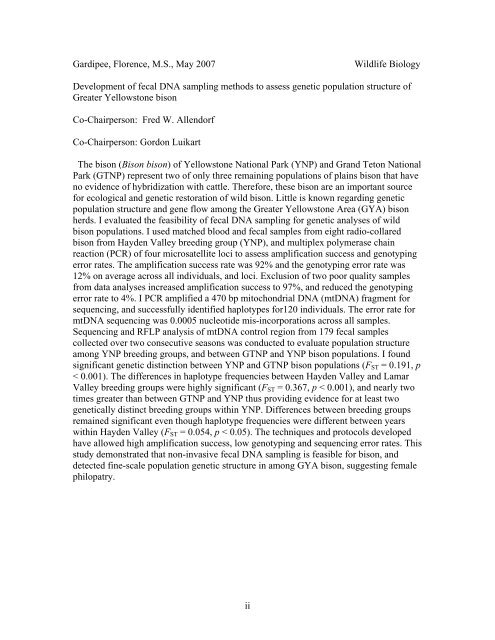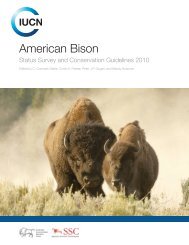Declaration Dr. Thomas H. Pringle - Buffalo Field Campaign
Declaration Dr. Thomas H. Pringle - Buffalo Field Campaign
Declaration Dr. Thomas H. Pringle - Buffalo Field Campaign
You also want an ePaper? Increase the reach of your titles
YUMPU automatically turns print PDFs into web optimized ePapers that Google loves.
Gardipee, Florence, M.S., May 2007 Wildlife Biology<br />
Development of fecal DNA sampling methods to assess genetic population structure of<br />
Greater Yellowstone bison<br />
Co-Chairperson: Fred W. Allendorf<br />
Co-Chairperson: Gordon Luikart<br />
The bison (Bison bison) of Yellowstone National Park (YNP) and Grand Teton National<br />
Park (GTNP) represent two of only three remaining populations of plains bison that have<br />
no evidence of hybridization with cattle. Therefore, these bison are an important source<br />
for ecological and genetic restoration of wild bison. Little is known regarding genetic<br />
population structure and gene flow among the Greater Yellowstone Area (GYA) bison<br />
herds. I evaluated the feasibility of fecal DNA sampling for genetic analyses of wild<br />
bison populations. I used matched blood and fecal samples from eight radio-collared<br />
bison from Hayden Valley breeding group (YNP), and multiplex polymerase chain<br />
reaction (PCR) of four microsatellite loci to assess amplification success and genotyping<br />
error rates. The amplification success rate was 92% and the genotyping error rate was<br />
12% on average across all individuals, and loci. Exclusion of two poor quality samples<br />
from data analyses increased amplification success to 97%, and reduced the genotyping<br />
error rate to 4%. I PCR amplified a 470 bp mitochondrial DNA (mtDNA) fragment for<br />
sequencing, and successfully identified haplotypes for120 individuals. The error rate for<br />
mtDNA sequencing was 0.0005 nucleotide mis-incorporations across all samples.<br />
Sequencing and RFLP analysis of mtDNA control region from 179 fecal samples<br />
collected over two consecutive seasons was conducted to evaluate population structure<br />
among YNP breeding groups, and between GTNP and YNP bison populations. I found<br />
significant genetic distinction between YNP and GTNP bison populations (FST = 0.191, p<br />
< 0.001). The differences in haplotype frequencies between Hayden Valley and Lamar<br />
Valley breeding groups were highly significant (FST = 0.367, p < 0.001), and nearly two<br />
times greater than between GTNP and YNP thus providing evidence for at least two<br />
genetically distinct breeding groups within YNP. Differences between breeding groups<br />
remained significant even though haplotype frequencies were different between years<br />
within Hayden Valley (FST = 0.054, p < 0.05). The techniques and protocols developed<br />
have allowed high amplification success, low genotyping and sequencing error rates. This<br />
study demonstrated that non-invasive fecal DNA sampling is feasible for bison, and<br />
detected fine-scale population genetic structure in among GYA bison, suggesting female<br />
philopatry.<br />
ii










